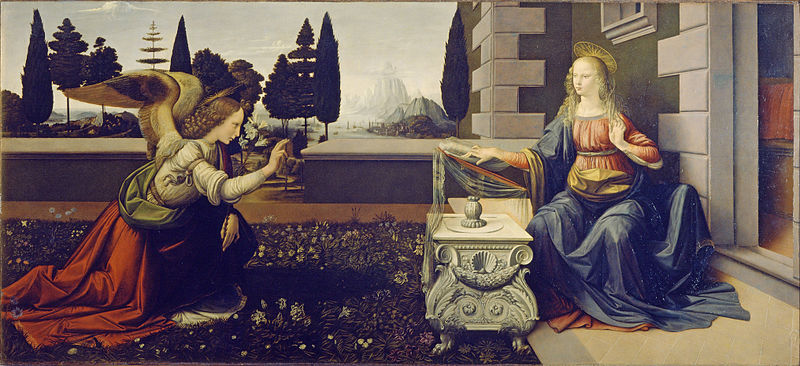| Annunciation | |
|---|---|
 |
|
| Artist | Leonardo da Vinci |
| Year | 1472-1475 |
| Medium | Oil and tempera on panel |
| Location | Uffizi, Florence, Italy |
| Dimensions | 39 in × 85 in |
| 98 cm × 217 cm | |
| Famous Paintings by da Vinci | |
| The Last Supper | |
| Mona Lisa | |
| Vitruvian Man | |
| The Baptism of Christ | |
| Annunciation | |
| Lady with an Ermine | |
| Ginevra de’ Benci | |
| Adoration of the Magi | |
| St. Jerome in the Wilderness | |
| View Complete Works |
The Leonardo da Vinci painting The Annunciation painted on oil and tempera on a 98 cm by 217 cm panel was originally attributed to another painter, Domenico Ghirliando. It was until 1869 when art experts from the nineteenth century recognized the painting style to be from the hand of the renowned Leonardo da Vinci executed in c. 1472 – c. 1475. The painting was perhaps made as an altarpiece and it was housed in the Convent of San Bartolomeo of Monte Oliveto just outside Florence, Italy until 1867 when the painting came to Uffizi.
There are two versions of the painting, one in Uffizi Gallery in Florence and the other in the Louvre Museum in Paris. The Uffizi version was the one first attributed to Ghirliando. The Louvre version was thought to be painted in c. 1478 – c. 1485. Both paintings are pronounced as made by Leonardo da Vinci although the Louvre version was doubtfully made by him according to experts.
The painting illustrates the Archangel Gabriel on his knees with his right hand raised towards Mary in greetings in the Florentine palace garden. Mary is depicted with her left hand gesture in response to the archangel’s greeting. The painting of Mary is in her three-quarter form sitting on a chair outside a room. The height, width and depth of the painting all meet in Mary’s spot and with Mary’s body outlined by the house’s cornerstones and her head emphasized by the dark wall. Mary’s importance is signified in the painting. The background landscape depicts tress and mountains under a grey and foggy sky.
The painting was recognized by the experts as made by the young Leonardo da Vinci because of the unmistakeable painting style of the artwork, especially with the details of draperies and clothing and the painting approach and atmosphere of the background. The ‘Leonardesque’ effect is seen with the shadows and lighting effects of the shading clearly seen in the painting.